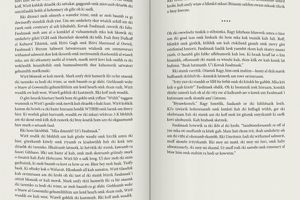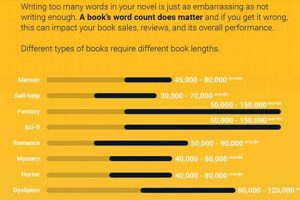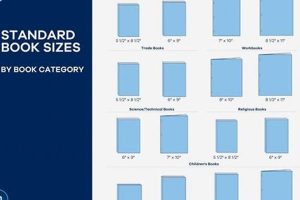The inquiry concerns identification of the literary work with the highest page count. This is typically assessed by examining published editions of novels, encyclopedias, or other lengthy texts, comparing their physical dimensions and explicitly stated page numbers. For instance, one might investigate the page number of a particularly large edition of a classic novel compared to a multi-volume encyclopedia to determine which contains the greater number of pages.
The determination of the book containing the greatest number of pages offers insight into publishing practices, textual composition, and the sheer scope of literary ambition. Understanding the parameters surrounding the physical manifestation of text highlights the evolution of bookbinding, printing technology, and reader expectations across different eras. Furthermore, it can illuminate cultural values regarding the storage and consumption of information.
Therefore, this discussion will address commonly cited candidates for the literary work with the highest page count, discuss the criteria used in making such a determination (including variations in font size and edition), and examine the challenges inherent in establishing a definitive answer to the inquiry.
Guidance on Determining the Book with the Highest Page Count
The following points outline key considerations for ascertaining which book contains the greatest number of pages. These guidelines are crucial for objective assessment, mitigating potential ambiguities arising from varying editions and formats.
Tip 1: Prioritize Physical Copies. Examine tangible, published books rather than digital versions. Digital pagination can be subject to formatting changes, hindering accurate comparisons.
Tip 2: Specify Edition. Always note the edition of each book being compared. Different editions may include variations in page count due to added content, altered formatting, or editorial revisions.
Tip 3: Establish Font Size Consistency. When comparing excerpts or sections, maintain a uniform font size and style. Font variations significantly impact the amount of text displayed on a single page.
Tip 4: Factor in Supplementary Material. Account for front matter (prefaces, introductions) and back matter (appendices, indices). Such elements contribute to the total page count and should not be disregarded.
Tip 5: Address Multi-Volume Works. When analyzing multi-volume works, consider the cumulative page count across all volumes, ensuring a fair comparison with single-volume publications.
Tip 6: Acknowledge Variations in Paper Stock. Thicker paper stock may artificially inflate a book’s apparent size. Ideally, books compared should have similar paper density to maintain accuracy.
Tip 7: Consult Bibliographic Databases. Utilize bibliographic resources to gather data on published editions, including accurate page counts and other relevant details, reducing reliance on solely physical inspection.
Adhering to these guidelines ensures a more precise and credible assessment of which book contains the greatest number of pages, reducing subjectivity and promoting consistency in comparative analyses.
The subsequent sections will explore specific books frequently cited in discussions concerning their potential status as the literary work with the highest page count, applying these methodological guidelines to evaluate their respective claims.
1. Page Count Defined
Page count, in the context of identifying the literary work with the highest page count, refers to the total number of numbered leaves within a bound volume, encompassing all content from the first page to the last. This definition serves as the primary quantitative metric when evaluating candidates. A comprehensive understanding of this definition is crucial; without it, any claim regarding the literary work with the highest page count lacks a foundational basis. The inherent relationship between the definition and the overarching question means that inaccurate or inconsistent methods of determining a page count directly undermines any assertion.
The precise definition of page count extends beyond a simple numerical value. It involves consideration of what constitutes a “page” in specific contexts. For example, in some instances, unnumbered pages, such as those containing illustrations or decorative elements, might be included in a formal count, depending on the publisher’s conventions. In other cases, blank pages found at the end of chapters or sections may or may not be included. These variations underscore the need for consistent application of the definition across all works being compared. To illustrate, if a novel like War and Peace is assessed, its page count needs to be consistently measured across all editions and similar books, adhering to the inclusion/exclusion rules of unnumbered and blank pages, to ensure a fair comparative analysis.
Ultimately, the precise definition of page count provides the necessary framework for comparing the physical size and textual scope of different literary works. This framework is essential for accurate assessments and avoids potential misrepresentations arising from inconsistent counting methodologies. As such, any serious attempt to identify the book with the highest page count must first establish and adhere to a robust definition of what constitutes a “page”, including the treatment of all ancillary material found within the book.
2. Edition Variations
Edition variations represent a critical factor when determining the literary work with the greatest number of pages. Distinct editions of the same title may exhibit significant differences in page count due to alterations in formatting, the inclusion or exclusion of supplementary material, or substantive revisions to the text itself. These variations directly impact comparisons aimed at identifying the book with the most pages, as the page number associated with one edition may not accurately reflect the length of other editions. For example, a revised edition of a novel might contain author’s notes or critical essays absent in the original publication, thereby inflating its page count.
The impact of edition variations extends beyond the mere addition of supplementary content. Publishers may alter the font size, line spacing, or margin widths to influence the overall page count. A larger font or wider line spacing, while making the text more accessible, will invariably increase the number of pages required to present the same volume of textual content compared to a more compact formatting style. Furthermore, the physical size of the book itself contributes to the final page count; a larger trim size allows for more words per page, potentially reducing the total number of leaves. Therefore, identifying the book with the most pages necessitates careful consideration of the specific edition being examined, accounting for all formatting and content-related variations.
Ultimately, recognizing the role of edition variations is essential to maintain accuracy and objectivity in determining the literary work with the greatest number of pages. Ignoring edition-specific characteristics may result in misleading conclusions. Comparative analyses must meticulously document the edition details of each work, including publisher, publication date, and any notable formatting or content differences. Such diligence promotes a more nuanced understanding of the factors contributing to page count and ensures that any claim concerning the literary work with the highest page count is grounded in verifiable evidence.
3. Font Size Impacts
Font size exerts a considerable influence on page count, which is a primary metric when considering “what book has the most pages.” Variations in font size, even seemingly minor ones, can significantly alter the number of pages required to accommodate a given volume of text. The relationship between font size and page count is inversely proportional; a smaller font allows for more words per page, reducing the overall page count, while a larger font decreases the word density per page, resulting in an increased page count.
- Direct Proportionality of Point Size to Page Count
A larger font size will inherently lead to a greater page count. This principle directly affects comparisons of books with identical text but different formatting. For instance, a childrens edition of Moby Dick with a 14-point font will undoubtedly have more pages than an academic edition printed in a 10-point font. The degree of difference in page count is directly related to the difference in font size, thereby complicating efforts to identify the literary work with the highest page count based purely on physical dimensions.
- Influence of Typeface on Page Density
Different typefaces, even at the same point size, exhibit varying widths and heights, impacting the number of characters that can fit on a single line and the number of lines that can fit on a page. A condensed typeface, such as Arial Narrow, will allow for greater character density compared to a wider typeface, such as Times New Roman. Consequently, a book typeset in a condensed typeface will have a lower page count than the same book typeset in a wider typeface, even if the point size remains constant. This effect highlights the nuanced relationship between font selection and the overall length of a printed work.
- Readability Considerations and Page Count Trade-offs
Font size is often a trade-off between readability and page count. Publishers may choose a larger font size to enhance readability for visually impaired readers or to appeal to a younger audience. This design choice inevitably increases the page count of the book. Conversely, publishers might opt for a smaller font size to reduce printing costs or to make a lengthy book appear less daunting. These intentional manipulations of font size demonstrate how page count can be artificially inflated or deflated for marketing and accessibility purposes.
- Longitudinal Impact of Formatting Standards
Over time, standard font sizes and formatting practices have evolved. A novel published in the 19th century might use a significantly smaller font size compared to a contemporary novel. This historical shift in formatting standards makes direct page count comparisons between older and newer books problematic. Any evaluation of the literary work with the highest page count must take into account the evolving typographic conventions and font size norms of different eras to ensure a fair assessment.
In summary, font size is a pivotal variable in determining the overall page count of a book. Its impact extends beyond simple proportional relationships to encompass typeface selection, readability considerations, and historical formatting practices. A comprehensive evaluation of the book with the most pages must carefully consider and account for these font-related factors to arrive at an accurate and meaningful conclusion.
4. Binding Methods
Binding methods, while not directly influencing the number of pages in a literary work, significantly affect the physical dimensions and overall bulk of a book. These physical attributes often contribute to perceptions of length and may be erroneously conflated with page count when assessing “what book has the most pages.” Therefore, understanding binding methods is crucial to accurately distinguish between physical size and actual page quantity.
- Paper Stock and Thickness
The choice of paper stock directly impacts a book’s thickness. Thicker paper increases the overall dimensions of the book, potentially giving the impression of a higher page count even if the number of leaves remains constant. For instance, a book bound with acid-free archival paper will generally be thicker than the same book bound with a thinner, less expensive paper stock. This difference is particularly relevant when comparing books across different eras, as paper manufacturing techniques have evolved significantly over time.
- Sewn vs. Adhesive Binding
Sewn bindings, such as Smyth sewing, create a more durable and often thicker book block compared to adhesive bindings like perfect binding. In Smyth sewing, individual signatures (groups of pages) are sewn together, resulting in a book that lies flatter and is less prone to page detachment. Perfect binding, on the other hand, uses adhesive to glue the pages together, creating a flat spine. While perfect binding is generally less expensive, it also tends to produce a thinner book block. Consequently, two books with identical page counts may exhibit different thicknesses depending on the binding method employed, affecting the perceived “size” and potentially influencing subjective assessments.
- Cover Material and Board Thickness
The choice of cover material and the thickness of the cover boards also contribute to a book’s overall dimensions. Hardcover books typically utilize thicker cover boards than paperback books, adding to the book’s bulk. Additionally, the material used for the cover, such as cloth, leather, or paper, can affect the perceived quality and weight of the book. While these factors do not directly alter the page count, they influence the tactile experience of the book and can contribute to subjective impressions of its length, which may be erroneously associated with the number of pages.
- Endpapers and Added Elements
Endpapers, decorative sheets that attach the book block to the cover boards, add to the overall page count, albeit minimally. Similarly, added elements such as ribbon markers, headbands, and tailbands, though functional and aesthetically pleasing, contribute to the overall dimensions of the book. Although these elements do not contain primary textual content, they are included in the binding process and contribute to the final physical form of the book. Their impact is relatively small compared to the effects of paper stock and binding style, but should be considered when comparing books across different editions or publishers.
In conclusion, while binding methods do not alter the inherent page count of a literary work, they profoundly influence the physical dimensions of the book, potentially creating discrepancies between objective page numbers and subjective perceptions of length. Assessments aimed at identifying “what book has the most pages” should therefore consider the binding method as a potentially confounding variable that can distort visual and tactile impressions of size.
5. Content Extent
Content extent, referring to the scope and comprehensiveness of a book’s subject matter, is inextricably linked to the question of “what book has the most pages.” The sheer volume of information included dictates the physical size required to contain it, directly influencing page count. A broader, more detailed coverage of a topic inherently demands more pages than a concise, selective treatment.
- Subject Matter Breadth and Page Count
The breadth of the subject matter significantly influences page count. Encyclopedic works attempting to cover a vast range of topics will invariably require more pages than books focused on a single, narrow subject. For instance, the Encyclopaedia Britannica, encompassing knowledge across all fields, possesses a considerably higher page count than a specialized monograph on, for example, string theory. The broader the subject, the more subtopics and details must be included, directly driving up the page count.
- Depth of Analysis and Detail
The level of detail and analytical depth also impacts page count. A comprehensive historical analysis that meticulously examines primary sources and offers nuanced interpretations will necessitate more pages than a superficial overview of the same historical period. Consider, for example, Robert Caro’s multi-volume biography of Lyndon B. Johnson; its extensive research and detailed narrative contribute to its substantial length, far exceeding that of shorter biographies focusing only on key events.
- Inclusion of Supplementary Material
The inclusion of supplementary materials, such as appendices, bibliographies, indices, illustrations, and footnotes, substantially increases page count. These elements, while not part of the main narrative, provide additional context, evidence, and resources for the reader. A scholarly edition of Shakespeare’s plays, complete with extensive footnotes and critical essays, will inherently have a higher page count than a plain text edition lacking these supplementary materials.
- Narrative Complexity and Style
The complexity of the narrative structure and writing style also influences page count. Dense, descriptive prose and intricate plot lines require more pages to unfold than simpler, more straightforward narratives. Marcel Proust’s In Search of Lost Time, characterized by its lengthy sentences and introspective explorations, occupies a considerable physical space due to its narrative style, demonstrating how stylistic choices can contribute to a high page count.
These facets demonstrate the intrinsic relationship between content extent and page count. Works aiming for maximal breadth, depth, supplementary detail, and stylistic complexity will inevitably contend for the title of “what book has the most pages,” highlighting the significant role content plays in determining a book’s physical dimensions and its overall contribution to the literary landscape.
Frequently Asked Questions
The following addresses common inquiries regarding the identification of the literary work possessing the greatest number of pages. Accuracy and clarity are prioritized in each response.
Question 1: What constitutes a definitive page count when editions vary?
A definitive page count requires specifying the precise edition under consideration, including publisher, publication date, and any unique formatting characteristics. Comparisons across multiple editions should acknowledge and account for any discrepancies arising from editorial revisions or design changes.
Question 2: How are multi-volume works treated in the determination of “what book has the most pages?”
For multi-volume works, the cumulative page count across all volumes is generally considered. This approach ensures a fair comparison with single-volume books. However, it is critical to explicitly state whether the cited page count refers to a single volume or the entire set.
Question 3: Does font size affect the validity of a page count comparison?
Yes, font size directly impacts page count. Comparisons should ideally be made between editions employing similar font sizes and typefaces. Significant variations in font can artificially inflate or deflate page numbers, leading to misleading conclusions.
Question 4: Are unnumbered pages included in a book’s official page count?
The inclusion of unnumbered pages, such as those containing illustrations or blank leaves, depends on the publisher’s conventions. Transparency is paramount; the method used to determine page count, including the treatment of unnumbered pages, must be clearly stated.
Question 5: How significant is paper thickness in accurately assessing page count?
Paper thickness can create visual misperceptions of page count. While not directly altering the number of leaves, thicker paper increases the book’s overall bulk. Assessments should prioritize actual page numbers over estimations based solely on physical dimensions.
Question 6: Is there a single, universally accepted “winner” for the literary work with the most pages?
Establishing a definitive “winner” is challenging due to the complexities of edition variations, formatting differences, and evolving publishing practices. Any claim should be supported by thorough documentation and a transparent methodology.
This FAQ underscores the nuanced approach necessary to addressing questions surrounding “what book has the most pages.” A rigorous methodology and attention to detail are essential for accurate assessments.
The following sections will provide insights into specific contenders for the title of the literary work possessing the greatest number of pages, along with a critical analysis of their respective claims.
Concluding the Investigation of “What Book Has the Most Pages”
The pursuit of identifying the literary work with the highest page count reveals a complex landscape. The investigation demonstrates the influence of edition variations, font size, binding methods, and the scope of content on a book’s physical dimensions. It becomes evident that no single, unambiguous answer exists, due to the subjective nature of defining “page” and the inconsistencies arising from diverse publishing standards.
While a definitive “winner” remains elusive, the exploration underscores the critical importance of methodological rigor and transparent documentation in comparative literary analysis. Further research into specific editions and consistent application of defined criteria are essential for informed evaluations. The pursuit should continue, contributing to a better understanding of both the physical and intellectual dimensions of literature.


![[Guide] How Many Words in a 300-Page Book? + Tips BoneyBooks | Discover Rare Books, Timeless Classics & Modern Reads Online [Guide] How Many Words in a 300-Page Book? + Tips | BoneyBooks | Discover Rare Books, Timeless Classics & Modern Reads Online](https://boneybooks.com/wp-content/uploads/2025/06/th-144-300x200.jpg)




